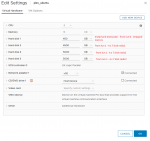el_pedriyo
Explorer
- Joined
- Jun 24, 2018
- Messages
- 65
Hello,
I have been using freenas last 6 months, so I am a little bit new still, I am not a big fan of bsd systems, just because already used to work on debian SOs, so I have been running VMs since then with byvhe. With this said, I am just mounting my datashares in my debian VMs with NFS and with CIFS in my windows pcs, so that I can access the same data. Running in my VMs, services like plex, nextcloud, and so on. This is working at the moment fine as it is, but I have the problem that with the VMs and NFS, I can not use inotify or data needs to be downloaded first to the VM and the uploaded to its destination, to arrive to the final place. I just wanted to know if this is how people is setting up their enviroments when trying to use VMs instead of jails.
Also I been questioning myself on how the isci option will be working. Because as far as I one if I make an isci volume to add it inside an ESXI as a datastore just for after mounting it into a VM as a local drive, and not as a network drive, inotify for example will be working fine, but NFS, SAMBA and other more services that freenas ofers, won't be working with the isci volume, as I do not know if other essential services more critical, like SMART will be working neither.
I will appreciate a lot if someone could guide me on what types of setups, refering to system setups are you using.
Kind regards
I have been using freenas last 6 months, so I am a little bit new still, I am not a big fan of bsd systems, just because already used to work on debian SOs, so I have been running VMs since then with byvhe. With this said, I am just mounting my datashares in my debian VMs with NFS and with CIFS in my windows pcs, so that I can access the same data. Running in my VMs, services like plex, nextcloud, and so on. This is working at the moment fine as it is, but I have the problem that with the VMs and NFS, I can not use inotify or data needs to be downloaded first to the VM and the uploaded to its destination, to arrive to the final place. I just wanted to know if this is how people is setting up their enviroments when trying to use VMs instead of jails.
Also I been questioning myself on how the isci option will be working. Because as far as I one if I make an isci volume to add it inside an ESXI as a datastore just for after mounting it into a VM as a local drive, and not as a network drive, inotify for example will be working fine, but NFS, SAMBA and other more services that freenas ofers, won't be working with the isci volume, as I do not know if other essential services more critical, like SMART will be working neither.
I will appreciate a lot if someone could guide me on what types of setups, refering to system setups are you using.
Kind regards


